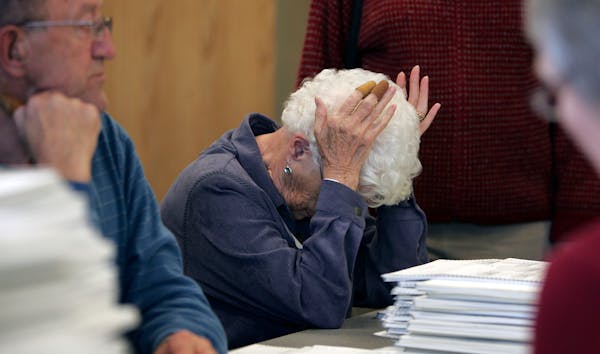The state Canvassing Board began sifting through the first of 1,500 challenged ballots in the disputed U.S. Senate race this afternoon, providing a tedious -- but sometimes eye-opening -- lesson in democracy under the gaze of reporters and lawyers for the campaigns of Republican Sen. Norm Coleman and DFLer Al Franken.
The process, at the outset anyway, was grindingly slow. In the first two hours, the board had ruled on 46 votes challenged by Franken. Of those, the board awarded 26 votes to Coleman, 7 to Franken and 13 to the pile for ballots where intend couldn't be determined or were disqualified because of marks that might identify the voter.
At times, the five-member board dispensed with some challenges in less than 30 seconds. But more often in the early going, members became bogged down in a morass of procedure and occasional disputes over what voters intended to communicate through wildly incomprehensible ballot markings.
Attorneys for the campaigns asked the board for permission to give it their views on controversial ballots, a request that was reluctantly granted for brief statements. "If we allot a specific amount of time, we could be here until Christmas -- next year," said Supreme Court Associate Justice G. Barry Anderson.
Gary Poser, state elections director, displayed the first of 441 ballots challenged by the Franken campaign on video screens in the legislative hearing room in St. Paul -- a vote from an Andover precinct in Anoka County. It showed marks in the ovals for both Franken and Coleman, but a more irregular one in Franken's.
Board Chairman Mark Ritchie, the secretary of state and a DFLer, moved to reject the challenge. After a second, the board unanimously approved the motion and awarded the vote to Coleman. It all took one minute.
"Can I just say, it felt really good to get started on this?" Ramsey County District Judge Kathleen Gearin said. "Yes, ma'am," Ritchie said.
And then it was off to the races. During the first hour, most of Franken's challenges were rejected, as is expected for most. But Franken picked up about 15 percent of the challenges he had raised, a 1-in-6 ratio that may be higher than some anticipated.
The board worked hard to strike a consistent course for similarly marked ballots. For instance, it generally awarded votes for candidates with fully blackened ovals even if the opponent's oval contained some markings, the thinking being that those voters had mistakenly begun to fill in one oval before correcting themselves.
On the other hand, stray marks surrounding a blackened oval generally convinced the board that the voter's intent was unclear. At one point, the board rejected three apparent votes for Coleman because lines through the oval suggested the voter may have been trying to cross out the vote.
"I feel another rejection of my motion coming," Ritchie often commented, anticipating the board's decision.
Board members often looked at how voters filled in the rest of the ballot to decide which Senate candidate they intended to support. For one ballot from Shevlin Township, the Coleman oval was blackened and the Franken oval had an X, which typically may result in a vote for Coleman. But the voter used X's on the rest of the ballot, and the board ruled it a vote for Franken.
At one point, the board got bogged down for several minutes on a ballot with the oval lightly filled in for Coleman. The Franken campaign challenged this ballot, contending that no vote was cast since the ovals for other offices were more filled in. After some back and forth among the board members, the ballot was set aside for discussion later.
Moments later, another ballot challenged by Franken stalled the review. The mark appeared to land precisely between the ovals for Coleman and candidate Dean Barkley. The divided board voted was added to the "other" pile, giving it to neither Coleman nor Franken.
"Clearly, this voter was challenged ... this is the only vote [on the ballot] that straddles two candidates," Ramsey County District Court Judge Ed Cleary said.
One ballot had a handwritten note attached. "I don't want to read notes -- we're not supposed to read Post-Its," said Chief Justice Eric Magnuson.
After a bit more confusion and verbal tussling, Ritchie plowed ahead, saying, "I move to review this right now. Let's get this over with, so we can get back to work." In short order, the Coleman challenge was rejected, and the vote was awarded to Franken.
Earlier today, state election officials began separating the ballots challenged by Franken from the ones he has withdrawn in preparation for the board to begin its arduous task.
The Coleman campaign withdrew 1,047 challenges Monday, leaving a total of just under 1,000 that will have to be reviewed by the board.
The board's challenge review is one of several steps it is taking toward declaring a winner, which the razor-thin results on Election Night failed to provide, prompting the recount. Also in dispute are hundreds of rejected absentee ballots that the Franken campaign says were wrongly set aside by election officials.
